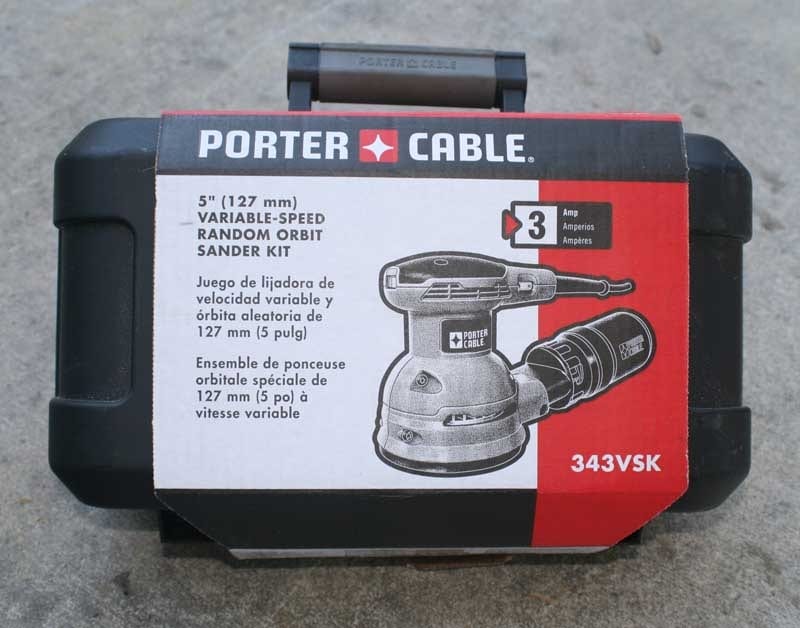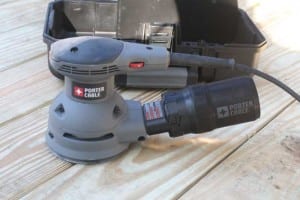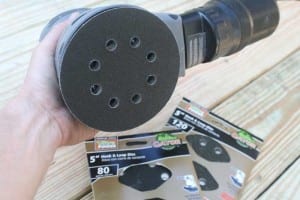When building fine woodwork, one of the most critical aspects of the project is sanding and finishing. Without that perfect finish, the whole project loses its polish. To achieve that ideal finish, several key factors must be considered, and one of these has to do with the way it was sanded. To help woodworkers of all levels of craftsmanship achieve a better final product, Porter-Cable has developed a new 5-inch Variable Speed Random Orbit Sander.
Build Quality and Features
Our test sander arrived in a cardboard-wrapped plastic hard case. Right off the cuff, we liked that the model 343VSK Random Orbital Sander came with a hard case. They also sell a version without the case, but we think that having the storage case is a better way to keep your tools protected and organized, especially when working in a tight shop space. The sander, detachable dust collection canister, and the instruction manual were inside the hard case. The outside body of the sander is made of tough ABS plastic with a black rubber grip area for your palm on the top. The on/off toggle switch is on the top near the front of the sander, so it is in very easy reach of your fingertips when you are holding it.
The variable speed dial is located towards the back of the top and uses a thumb wheel to set the orbit speed from 7,000 to 12,000 orbits per minute. On the bottom, the sanding disks are held in place with hook and loop, and just about any 5″ sanding disks will fit it (just be sure to select one with an eight-hole pattern). The dust collection canister was interesting, being that it is not the soft cloth bag like many sanders. This one is made of hard, porous polyurethane, which they call POREX. For those of you who like to connect a vacuum to your sander, the dust outlet accommodates both 1″ and 1-1/2″ vacuum hoses.
Testing and Use
To start, we went and picked up some standard off-the-shelf sanding disks from Gator Finishing Products. The sanding pads that we chose were the 5″ diameter with 8 holes. These pads are made with aluminum oxide grit and have a red resin coating applied to help resist breakdown from heat and humidity. What we liked is that when we went to place the sanding pads on the sander, the holes for the dust removal lined up perfectly.
We have found that this is not always the case with lower-quality sanding pads. With some 120-grit sandpaper loaded on the sander, we started working on our sample 1×4 piece of pine. One of the first things we noticed was how the sander was relatively quiet and nearly free of vibration.
This is great because most palm-style sanders will put your arm to sleep after an extended session of sanding, not to mention the drone of a palm sander, which can be pretty tough to take for a long time, too. Our initial setting for the orbits per minute was set to the highest setting of 12,000. Material removal was decent and consistent. Even under very close inspection of the sanded wood, we never saw any of the orbital action cut into the wood, which is what we would hope for with this type of sander. To further experiment with the variable speeds, we took it all the way down to 7,000 orbits per minute and, as predicted, our material removal rate went to about half or less.
Auto-Stop and Dust Collection
One of the cool features of this sander that we picked up on is that when you remove it from your work piece, the sanding disk stops spinning. This is helpful because, if you are working on multiple work pieces, you will never mar or scratch up a surface from having a spinning disk touching it. Something else we noticed when we were using the sander is that, since it has a pretty powerful motor, even when we were bearing down on the sander pretty hard, it did not slow down. Dust collection for the sander was OK.
Most of the dust was removed from the workpiece as we were sanding on it, but it did seem like only about 60% of the dust was actually collected inside the dust cup. We were hoping for a little better result with the attached dust collection system. Of course, the best way to remove dust is to connect your vacuum to the sander, and in this case, with a vacuum connected, you can make your sander virtually dust-free. The good news is that the connection for the dust cup will easily accommodate a 1″ or 1-1/2″ vacuum hose.
Conclusion
The Porter Cable 343VSK Random Orbital Sander has a pretty good combination of features for a decent price. We liked the variable speed functionality and the included storage case. For the few dollars extra that these features cost above the basic model, we think it is worth the extra money. We are pretty sure that this sander will have the capability to help you achieve that quality finish you are looking for on your woodworking projects.
For our value rating, we gave this sander a 5/10 since it does cost a little more than many similar sanders currently on the market. For our performance rating, we gave the sander a 7/10 since it is pretty quiet, almost vibration-free, and has variable speed. Had it done a slightly better job of dust collection, we might have upped the score by another point.





